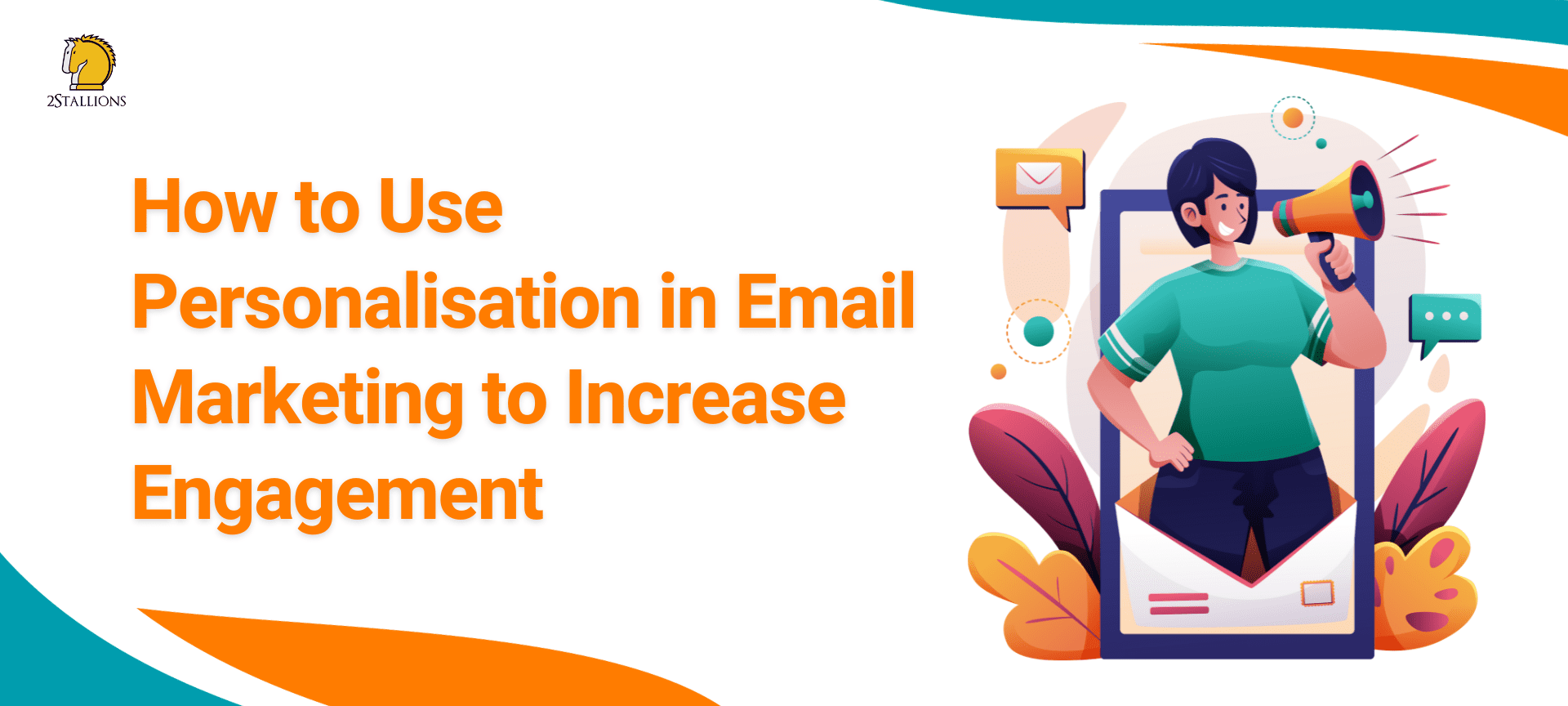SHARE

Email marketing has become one of the most effective ways to engage with customers and drive business growth. However, with the sheer volume of emails individuals receive daily, it’s crucial to stand out from the crowd.
Personalisation is the key to achieving this. You can increase engagement and conversion rates by tailoring your emails to meet each recipient’s unique preferences and needs.
In this article, we will explore the importance of personalisation in email marketing and provide practical tips on how to personalise your email campaigns effectively.
[thrive_leads id=’8305′]
Understanding the Importance of Personalisation in Email Marketing
Email personalisation goes beyond simply addressing the recipient by their name. It involves delivering relevant and tailored content based on the recipient’s interests, demographics, and past interactions with your brand.
Personalisation helps create a sense of familiarity and builds trust, increasing the likelihood of recipients opening, reading, and engaging with your emails.
When it comes to email marketing, standing out in a crowded inbox is crucial. With the average person receiving dozens of emails daily, grabbing their attention and making a lasting impression is essential. Personalisation is the key to achieving this.
By customising your emails to suit the individual recipient, you can cut through the noise and deliver a message that resonates with them on a personal level.
Imagine receiving an email that addresses you by name, offers products or services that align with your interests, and provides valuable information tailored to your needs.
This level of personalisation not only grabs your attention but also makes you feel valued as a customer. It shows that the sender has taken the time to understand your preferences and is genuinely interested in providing you with a meaningful experience.
The Role of Personalisation in Customer Engagement
Personalised emails demonstrate that you value your customers as individuals, not just as another entry in your database.
When recipients feel understood and appreciated, they are more likely to take the desired action, whether making a purchase, signing up for a webinar, or sharing your content on social media.
Customer engagement is a vital aspect of any successful marketing strategy. By personalising your emails, you can create a connection with your audience that goes beyond the transactional nature of business.
When customers feel a sense of personal connection with a brand, they are more likely to become loyal advocates who continue to engage with your brand and spread positive word-of-mouth recommendations to their friends and family.
Furthermore, personalisation allows you to segment your audience and target specific groups with tailored messages.
By understanding the unique preferences and needs of different customer segments, you can deliver highly relevant and valuable content to each group. This targeted approach increases the chances of conversion and drives customer satisfaction.
The Psychology Behind Personalised Emails
Personalisation taps into the fundamental human desire for recognition and relevance. By tailoring your email content, you can create a psychological bond with your recipients, making them feel seen and understood.
This emotional connection increases the likelihood of recipients engaging with your brand and becoming loyal customers.
When a person receives an email that speaks directly to their interests, it triggers a positive emotional response.
They feel acknowledged and appreciated, which fosters a sense of trust and loyalty towards the brand. This emotional connection can profoundly impact customer behaviour, influencing their decision-making process and ultimately driving them to take action.
Moreover, personalisation allows you to leverage behavioural data to anticipate customer needs and preferences.
By analysing past interactions and purchase history, you can tailor your email content to align with their specific interests. This level of personalisation enhances the customer experience and increases the likelihood of repeat purchases and long-term customer loyalty.
The Basics of Personalising Your Email Marketing
Gathering relevant customer data and segmenting your email list is essential to personalise your email campaigns. This ensures you deliver the right message to the right audience at the right time.
Gathering Relevant Customer Data
Start by collecting customer data through various touchpoints, such as website forms, purchase history, and surveys. This data can include demographics, preferences, behaviours, and past interactions with your brand.
The more information you have, the better you can tailor your emails to suit each recipient’s needs.
For example, let’s say you run an online clothing store. By collecting data on your customers’ preferences, such as their preferred style, colour choices, and sizes, you can send them personalised recommendations and offers that align with their individual tastes.
This level of personalisation enhances the customer experience and increases the likelihood of conversion.
Additionally, gathering data on your customers’ past interactions with your brand can provide valuable insights.
For instance, if a customer has abandoned their shopping cart in the past, you can send them a follow-up email with a special discount code to encourage them to complete their purchase.
By leveraging this data, you can create targeted campaigns that address specific pain points and drive customer engagement.
Segmenting Your Email List for Personalised Campaigns
Segmentation is the process of dividing your email list into smaller, more targeted groups based on specific criteria. This could include factors such as location, age, purchase history, or product preferences.
By segmenting your list, you can create highly targeted campaigns that speak directly to each segment’s unique needs and interests, resulting in higher engagement and conversion rates.
Let’s explore an example to illustrate the power of segmentation. Imagine you own a travel agency, and you have customers from different age groups. By segmenting your email list into age brackets, you can tailor your campaigns to suit the preferences and interests of each group.
For instance, you can send exclusive holiday packages to your younger audience, who may be more interested in adventurous trips, while offering relaxing getaways to your older customers who prefer a more tranquil vacation experience.
Furthermore, segmenting your email list based on purchase history can help you create targeted upselling and cross-selling campaigns. For instance, if a customer has recently purchased a camera from your online store, you can send them emails with complementary accessories or photography tips.
By understanding your customers’ purchase behaviour, you can provide them with relevant and valuable content that enhances their overall experience with your brand.
Personalising your email marketing involves gathering relevant customer data and segmenting your email list. By doing so, you can create highly targeted campaigns that resonate with your audience, resulting in increased engagement, conversion rates, and customer satisfaction.
So, start collecting data and segmenting your list today to take your email marketing to the next level!
Creating Personalised Email Content
Once you have gathered the necessary data and segmented your email list, it’s time to create personalised email content that resonates with each recipient.
Writing Personalised Email Subject Lines
The subject line is the first thing recipients see when they receive your email. Make it personal and compelling to grab their attention.
Use their name, reference past purchases, or include exclusive offers tailored to their interests. A personalised subject line increases the chances of your email being opened and read.
Tailoring Email Content to Individual Preferences
Personalised email content should go beyond simply addressing the recipient by name. It should provide valuable information, offer relevant products or services, and demonstrate an understanding of their preferences.
Use dynamic content to dynamically adjust email content based on recipient data, such as location or previous interactions.
This level of personalisation helps establish a deeper connection and encourages recipients to take the desired action.
Measuring the Success of Your Personalised Email Campaigns
To ensure the effectiveness of your personalised email campaigns, it’s crucial to track key metrics and interpret the data to make informed improvements.
Key Metrics to Track in Personalised Email Marketing
Some essential metrics to monitor include open, click-through, conversion, and unsubscribe rates.
Analyse this data to identify trends, patterns, and areas for improvement. Pay attention to engagement metrics specific to your business goals, such as product views, downloads, or event registrations.
Interpreting Data and Making Improvements
Use the insights gained from your data analysis to refine your email personalisation strategy. Experiment with variables such as subject lines, content formats, and call-to-action placements to optimise engagement and conversion rates.
Continuously test and iterate to ensure you are delivering the most effective personalised email campaigns.
Overcoming Common Challenges in Personalised Email Marketing
While personalisation can significantly enhance your email marketing efforts, there are some pitfalls to be aware of.
Balancing Personalisation and Privacy
Customers appreciate personalised content, but they also value their privacy. Ensure you are transparent about collecting, storing, and using their data.
Obtain explicit consent before personalising your emails and offer an easy way for recipients to opt out if they no longer wish to receive personalised communications.
Avoiding Common Pitfalls in Personalised Email Campaigns
Avoid over-personalisation that feels intrusive or creepy. Strive for a balance between personalisation and general relevance. Regularly review and update your customer data to ensure accuracy and relevance.
In conclusion, personalisation is a powerful tool in email marketing, enabling you to deliver tailored content that resonates with your audience.
By understanding the importance of personalisation, mastering the basics, creating personalised email content, and measuring the success of your campaigns, you can increase engagement and drive better results.
Overcome challenges by balancing personalisation with privacy and avoiding common pitfalls. Start harnessing the power of personalisation in your email marketing today to see improvements in customer engagement and conversion rates.





